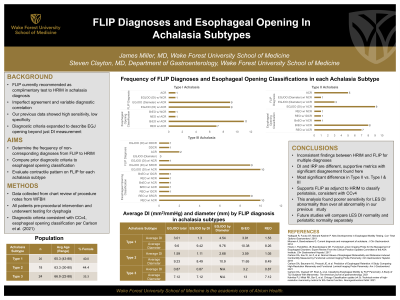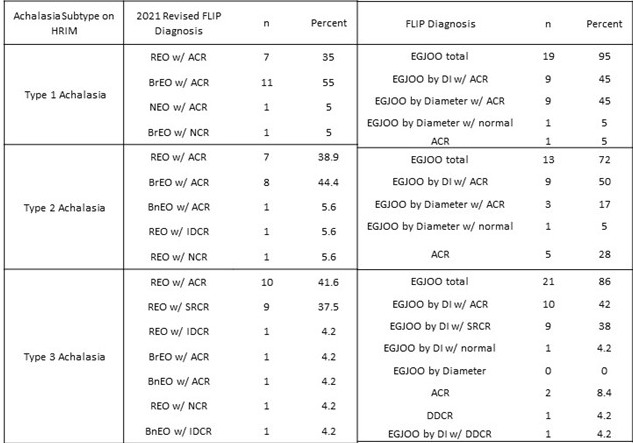Tuesday Poster Session
Category: Esophagus
P3274 - FLIP Diagnoses in Cases of Achalasia Subtypes
Tuesday, October 24, 2023
10:30 AM - 4:00 PM PT
Location: Exhibit Hall

Has Audio
- JM
James Miller, MD
Wake Forest University School of Medicine
Charlotte, NC
Presenting Author(s)
James Miller, MD1, Steven Clayton, MD2
1Wake Forest University School of Medicine, Charlotte, NC; 2Wake Forest University School of Medicine, Winston-Salem, NC
Introduction: The functional lumen imaging probe (FLIP) can identify disorders of esophagogastric junction outflow obstruction (EGJOO) as an adjunct test to high resolution manometry (HRIM). The FLIP metric distensibility index (DI) less than 2.0mm2/mmHg was associated with poor deglutitive relaxation of the lower esophageal sphincter on HRIM. Carlson et al. (2021) refined the diagnostic criteria to describe EGJ opening. The aim of our study was to compare the prior EGJOO diagnostic criteria vs the newly described classifications for EGJ opening in patients with symptomatic achalasia on HRIM. A secondary aim was to evaluate the panometry contractile pattern associated with each achalasia subtype.
Methods: Data was collected from patients who underwent both HRIM and FLIP for work up of dysphagia. Achalasia diagnosis by HRIM was based on criteria established in Chicago Classification version 4. FLIP diagnoses were based on the FLIP White paper and refined EGJ opening criteria described by Carlson et al. (2021).
Results: In Type I Achalasia (n=20), 35% were classified as REO with ACR and 55% BrEO with ACR using revised diagnostic criteria, versus 45% EGJOO diagnosed by DI and 45% EGJOO diagnosed by max diameter < 12mm. Average DI for cases of BrEO and REO was 3.91 mm2/mmHg and 1.53 mm2/mmHg, respectively (p=0.013). Average max diameter for cases of BrEO and REO was 10.38mm and 8.26mm, respectively (p=0.013).
In Type II Achalasia (n=18), 39% were classified as REO with ACR and 44% BrEO with ACR versus 50% as EGJOO by DI, 17% as EGJOO by max diameter, and 28% as ACR.
In Type III Achalasia (n=24), 42% were classified as REO with ACR and 38% REO with SRCR vs 86% EGJOO by DI with 0 as EGJOO by max diameter.
Discussion: In Type I achalasia, we observed that those diagnosed with EGJOO by max diameter criteria were classified as BrEO with ACR under updated criteria. Average DI was significantly different (p=0.013) between BrEO and REO, suggesting that BrEO classification will most commonly be due to diameter criteria.
In Type II achalasia, we observed that those diagnosed with just ACR using prior criteria were reclassified as either BnEO with ACR or BrEO with ACR. These updated criteria proposed by Carlson et al. revealed clinically relevant EGJOO.
Contractile pattern on FLIP showed high level agreement with manometric diagnoses in Types I and II, and was expectedly variable in Type III. This supports current recommendations for FLIP as adjunct to manometry to classify peristaltic pattern.

Disclosures:
James Miller, MD1, Steven Clayton, MD2. P3274 - FLIP Diagnoses in Cases of Achalasia Subtypes, ACG 2023 Annual Scientific Meeting Abstracts. Vancouver, BC, Canada: American College of Gastroenterology.
1Wake Forest University School of Medicine, Charlotte, NC; 2Wake Forest University School of Medicine, Winston-Salem, NC
Introduction: The functional lumen imaging probe (FLIP) can identify disorders of esophagogastric junction outflow obstruction (EGJOO) as an adjunct test to high resolution manometry (HRIM). The FLIP metric distensibility index (DI) less than 2.0mm2/mmHg was associated with poor deglutitive relaxation of the lower esophageal sphincter on HRIM. Carlson et al. (2021) refined the diagnostic criteria to describe EGJ opening. The aim of our study was to compare the prior EGJOO diagnostic criteria vs the newly described classifications for EGJ opening in patients with symptomatic achalasia on HRIM. A secondary aim was to evaluate the panometry contractile pattern associated with each achalasia subtype.
Methods: Data was collected from patients who underwent both HRIM and FLIP for work up of dysphagia. Achalasia diagnosis by HRIM was based on criteria established in Chicago Classification version 4. FLIP diagnoses were based on the FLIP White paper and refined EGJ opening criteria described by Carlson et al. (2021).
Results: In Type I Achalasia (n=20), 35% were classified as REO with ACR and 55% BrEO with ACR using revised diagnostic criteria, versus 45% EGJOO diagnosed by DI and 45% EGJOO diagnosed by max diameter < 12mm. Average DI for cases of BrEO and REO was 3.91 mm2/mmHg and 1.53 mm2/mmHg, respectively (p=0.013). Average max diameter for cases of BrEO and REO was 10.38mm and 8.26mm, respectively (p=0.013).
In Type II Achalasia (n=18), 39% were classified as REO with ACR and 44% BrEO with ACR versus 50% as EGJOO by DI, 17% as EGJOO by max diameter, and 28% as ACR.
In Type III Achalasia (n=24), 42% were classified as REO with ACR and 38% REO with SRCR vs 86% EGJOO by DI with 0 as EGJOO by max diameter.
Discussion: In Type I achalasia, we observed that those diagnosed with EGJOO by max diameter criteria were classified as BrEO with ACR under updated criteria. Average DI was significantly different (p=0.013) between BrEO and REO, suggesting that BrEO classification will most commonly be due to diameter criteria.
In Type II achalasia, we observed that those diagnosed with just ACR using prior criteria were reclassified as either BnEO with ACR or BrEO with ACR. These updated criteria proposed by Carlson et al. revealed clinically relevant EGJOO.
Contractile pattern on FLIP showed high level agreement with manometric diagnoses in Types I and II, and was expectedly variable in Type III. This supports current recommendations for FLIP as adjunct to manometry to classify peristaltic pattern.

Figure: Figure 1: Comparison of FLIP diagnoses between previous and updated diagnostic criteria, separated by EGJOO criteria
Disclosures:
James Miller indicated no relevant financial relationships.
Steven Clayton indicated no relevant financial relationships.
James Miller, MD1, Steven Clayton, MD2. P3274 - FLIP Diagnoses in Cases of Achalasia Subtypes, ACG 2023 Annual Scientific Meeting Abstracts. Vancouver, BC, Canada: American College of Gastroenterology.

